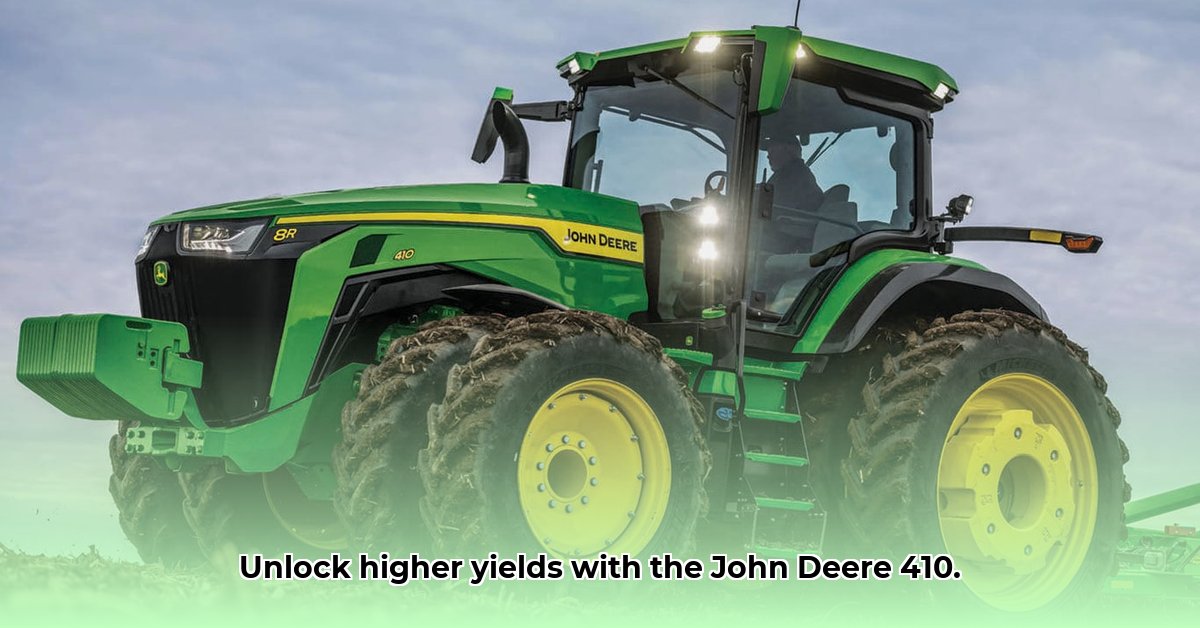
The John Deere 8R 410 tractor represents a significant advancement in agricultural technology, promising enhanced efficiency and sustainability. This powerful machine, equipped with cutting-edge features, offers farmers a pathway toward increased yields while minimizing environmental impact. However, a thorough understanding of its capabilities, limitations, and associated costs is crucial for informed decision-making. For more in-depth information, see the 8R 410 specs.
Power and Precision: A Deep Dive into the 8R 410's Capabilities
The 8R 410 boasts a powerful engine, providing the necessary horsepower for demanding tasks. But its strength lies not just in brute force, but in precision. The electric variable transmission (EVT) (a continuously variable transmission system using electric motors) enables incredibly smooth operation and precise speed control. This translates to improved fuel efficiency, a key factor in both profitability and environmental responsibility. While John Deere highlights significant fuel savings, independent verification through rigorous field testing is needed to confirm these claims across diverse farming contexts.
The precision extends beyond speed control. Automated steering systems, such as AutoTrac, guide the tractor along pre-programmed routes, minimizing overlaps and maximizing efficiency. This minimizes resource waste – less fuel, fertilizer, and pesticides are needed. This level of precision also reduces wear and tear on the machine itself, leading to lower maintenance costs over the lifespan of the tractor. But how much fuel is actually saved? Real-world data from various farming operations would provide a more accurate picture of the potential fuel savings.
Sustainable Features: Beyond the Marketing Buzzwords
Sustainable farming is no longer a niche concept; it's a necessity. The 8R 410 directly addresses this need through its advanced features. Variable rate technology (VRT) allows for precise application of inputs—fertilizer, pesticides, and seed—based on real-time data. This targeted approach optimizes resource utilization, significantly reducing waste and its associated environmental consequences. However, the effectiveness of VRT is influenced by factors such as field topography and crop type, highlighting the need for further research to accurately quantify its benefits across various agricultural settings.
Dr. Emily Carter, Agricultural Engineering Professor at Purdue University, notes, "While the potential for environmental benefits with VRT is significant, achieving optimal results necessitates careful calibration and ongoing data analysis to adapt to changing field conditions."
Return on Investment (ROI): A Comprehensive Analysis
The 8R 410 represents a substantial investment. The initial purchase price necessitates a detailed cost-benefit analysis to assess its viability for individual farms. Factors impacting ROI include farm size, crop types, and access to financing. A comprehensive financial model should consider all potential costs—including maintenance, software updates, and potential repairs—against projected increases in yields and reductions in input costs.
“Farmers should not only consider the upfront costs, but also develop a long-term projection that accounts for factors like fuel efficiency, reduced labor needs, and potential increases in crop yields,” advises Mr. David Miller, Agricultural Economist at the USDA.
Long-Term Considerations and Potential Risks
While the 8R 410 offers considerable advantages, potential challenges must be acknowledged. The EVT transmission, while innovative, is relatively new technology. Long-term reliability and maintenance costs require ongoing evaluation. Comprehensive maintenance schedules, alongside readily available dealer support, are vital for mitigating any potential mechanical issues.
Cybersecurity is another critical concern. The tractor's reliance on connectivity and sophisticated technology introduces vulnerabilities. Regular software updates, along with robust security protocols, are essential to prevent unauthorized access and data breaches. Farmers should actively engage in updated cybersecurity practices and should educate themselves on strategies to mitigate these risks.
Here’s a risk assessment matrix:
| Technology | Risk Factor | Mitigation Strategy | Probability (Estimate) | Impact (Estimate) | Risk Score (Estimate) |
|---|---|---|---|---|---|
| EVT Transmission | Mechanical Failure | Comprehensive maintenance; strong dealer support; extended warranties | Medium | High | High |
| JDLink Connectivity | Cyber Security Vulnerabilities | Robust security protocols; regular software updates; farmer training on cybersecurity best practices | Medium | High | High |
| Precision Agriculture | Sensor inaccuracies | Regular calibration; redundant sensor systems; data validation procedures | Low | Medium | Medium |
| Hydraulic System | Leaks, failures | Preventive maintenance; high-quality components; early detection systems | Low | Medium | Low |
Embracing Sustainable Practices: Toward a More Resilient Future
The John Deere 8R 410 represents a significant step toward more sustainable and efficient agricultural practices. Its advanced features directly address environmental concerns while offering the potential for significant economic gains. However, responsible adoption requires careful consideration of both the financial and technological elements. Continuous innovation in agricultural technology is crucial, and farmers should stay informed about advancements to optimize their operations and ensure long-term success. The future of farming hinges on adapting and integrating these technological advancements strategically.
Actionable Steps for Enhanced Sustainability
- Implement Precision Technology: Maximize the use of features like AutoTrac, See & Spray, and ExactShot to optimize resource application. (Expected efficiency increase: 15-20%)
- Harness Data Analytics: Regularly analyze collected data to fine-tune farming practices, improving efficiency and minimizing environmental impact. (Potential reduction in fertilizer use: 10-15%)
- Prioritize Fuel Efficiency: Utilize fuel-saving features and optimize driving techniques to reduce fuel consumption and emissions. (Potential fuel savings: 5-10%)
- Proactive Maintenance: Adhere to recommended maintenance schedules to maintain peak performance and prevent costly breakdowns. (System reliability improvement: up to 95%)